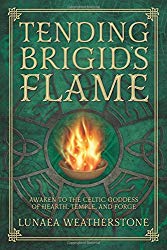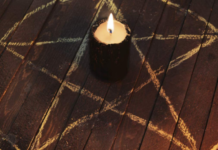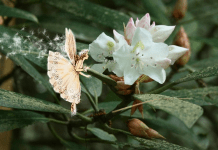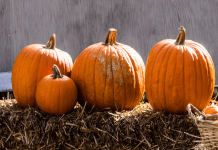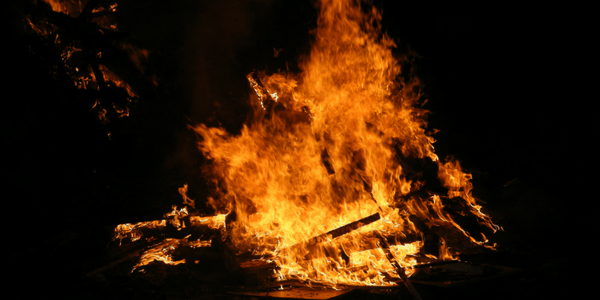
Tending Brigid’s Flame: Awaken to the Celtic Goddess of Hearth, Temple, and Forge, by Lunaea Weatherstone
Llewellyn Worldwide, 9780738740898, 288 pp., 2015
Brigid is a Celtic goddess who has drawn me into her world (and made her way into my bookshelf) through the ongoing presence of Celtic lore in contemporary Pagan witchcraft. I had seen her name, heard of her healing waters, her forge and her fiery red hair, and felt her rhythm in the power of three and the phases of the moon.
In the prologue to Tending Brigid’s Flame, Lunaea Weatherstone recounts her own journey to the goddess Brigid. After coming to a crossroads in her spiritual path in the 1990s, she had a diloggun reading with Yoruban priestess Luisah Teish.1 The oracle affirmed Weatherstone’s call to priestesshood, and declared her as a daughter of Oshun, who would welcome her into her tradition if she desired. All that was left was to consult her ancestors.
Enter Brigid. Knowing she needed to follow “her own ancestral roots,” Weatherstone soon realized that what undergirded the Paganism, Wicca, and Earth-based worship she already participated in was the mythology and folk traditions of the Celtic world, found in the myths of bards, the fae, and a pantheon of Celtic goddesses, of which Brigid was only one. Many white women in goddess spirituality seek out a matron goddess, and for many Brigid’s Celtic and later Christian context make her a suitable fit for those not looking to appropriate goddesses from other cultural contexts. I think it is a good idea for white women in witchcraft communities to learn more about Brigid and her influence, as well as the relationship between Celtic spirituality and witchcraft as we popularly understand it, as it untangles some of the origin stories of modern Pagan ideas. This is what led me to Brigid in the first place!
Brigid is a Celtic goddess of poetry, as well as of “hearth, temple, and forge” and this book seeks to know her through these three categories. Over five chapters, we learn bits and pieces of her history and lore, but the core of the book is dedicated to practical ways to relate or know Brigid as a contemporary Celtic Pagan deity.
The second chapter, “Hearth: Welcoming the Flame,” introduces the importance of Celtic hospitality and a number of instructions for making one’s home and hearth blessed, safe, and warmed with the spirit of Brigid. This chapter includes notes on home altars and shrines, sacred hospitality, an elemental home blessing ritual, ways to welcome the wee folk to your home, and directives for making a Brigid’s cross, homemade butter, and a number of other sweet offerings.
“Temple: The Devotional Flame” discusses Brigid within the context of Celtic Reconstructionism and contemporary Pagan worship. Topics include the the triskele and Triquetra, the Triple Goddess, Brigid’s relationship to other goddesses (both in the Celtic pantheon and “across the seas”), the Wheel of the Year, Brigid’s seasonal moons, and other earthly allies such as animals, plants, stones, and holy wells and springs. In this chapter, I feel that the sections on worship, devotion, and prayer were the strongest, and for beginners seeking to form a genuine connection with the goddess, this seems to me the most practical section in the book as it outlines a devotional reading and writing practice, as well as a number of inspiring prayers to Brigid, and instructions for following the Brigidine flame cycle (a candle lighting ritual followed by the Brigidine nuns).
In “Forge: The Transforming Flame,” Weatherstone takes up all of the practices in which one seeks Brigid’s transformative powers, or Brigid as creatrix. Her fiery and watery aspects are interpreted in this book as sources of passion, creation, and inspiration. Brigid’s relationship to metal work, poetry and the arts, and her role as healer, midwife, warrior and foster mother are also covered. There are instructions for making your own Brigid rosary, an icon for Brigid, and a crios Bride or Brigid’s girdle, as well as notes on oaths and prayers, and meditative journeys.
The fifth chapter is short, and includes reflections on service and charity with words by Selena Fox. There is also a set of prayers to perform alongside the 19-day Brigidine candle cycle, discussed in chapter three.
The most disappointing chapter in this book is the first chapter, “The Source of the Flame,” which serves as an introductory historical chapter to talk of Brigid’s origins. It is short (just 13 pages) and simple. So, if you are looking for a very short introduction, perhaps it’s a great sampler, but I found it very underwhelming. While there is history dispersed throughout the book, it is light, and I wish I could have gotten a little more at the start because context matters. If I was picking this up as my first book on Brigid, I would have been turned off, but perhaps this is just personal preference. If you’re looking for a read on Brigid that has a bit more historical context integrated, and at the same time includes a narrative recounting the personal relationship between Brigid and a priestess, I highly recommend Courtney Weber’s Brigid: History, Mystery, and Magick of the Celtic Goddess.2
At first look I assumed Tending Brigid’s Flame to be sole authored, as only Weatherstone’s name appears on the cover, but in fact the book includes significant contributions from Brigid’s priestesses and other flame keepers: Wendy Alford (artist blacksmith), Jenny Beale (founder of Brigid’s Garden), Sharon Blackie (author), Joanna Powell Colbert (interdisciplinary creatrix), Jen Delyth (painter and illustrator), Pat Fish (a Celtic tattooer for more than three decades) Selena Fox (priestess), Mara Freeman (director of the Avalon mystery school), Erynn Rowan Laurie (poet), Ellen Lorenzi-Prince (creator of the Dark Goddess Tarot), Margie McArthur (Archdruidess of Dana of the Fellowship of Isis), Mael Brigde (leader of Daughters of the Flame), Mickie Mueller (artist), Domi O’Brien (priestess), Rebecca Reeder (healer), Susan Smith (Celtic shamanic practicioner), Ruth Temple (fiber artist), Lisa Thiel (artist and priestess), and Marvelle Thompson (creator of the book Blessed Are These Hands). I list all of these contributors here because I hope that for those who may know and love the work of these folks knows it can be found in this book.
In theory I like the organization of this book (I am all about detailed structure and a great table of contents, as well as multi-authorship), but in practice it makes for not the most pleasant cover to cover read, and I would say that this book is one of those Llewellyn titles you add to your shelf to pull out for inspiration or instruction from time to time. I also wish that I could find the work from the contributors in the table of contents itself, and that they were credited within that section for their efforts rather than hidden away in the pages and the contributors list at the end. The front cover and table of contents are a bit misleading.
Lunae Weatherstone has been in service to the woman-spirit community for more than 30 years, and has been in relationship with Brigid now for at least 10 years, if not more. This book really springs out of this context, and speaks to this audience. Many times throughout Tending Brigid’s Flame, modernist and at times essentialist statements about “all women” and their particular magical powers pop up — so please, take note if that is something which you don’t sit easy with.
If you are devoted to Brigid, or she calls your name in some way, Tending Brigid’s Flame will be a useful guide for finding out different ways to engage with her, and I appreciate it most for the way that it brings Brigid’s priestesses and devotees together under one cover. That said, the effect of multi-authorship is that the narrative within the text from start to finish is lacking, and this book reads more like an activity guide, and in some ways reminds me of many of the seasonal sabbat books that Llewellyn publishes. This book shares prayers, rituals, and other creative devotions by priestesses with deep devotional relationships to the Brigid, which I respect and appreciate, and for this reason, it will continue to hold a place on my shelf.
Image credit: Tim Difford
- p. xx [↩]
- Read Jenna Danchuk’s review of Brigid: History, Mystery, and Magick of the Celtic Goddess. [↩]


